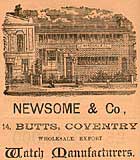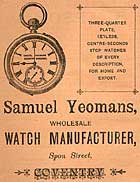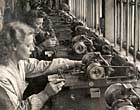

![]()
watchmaking
the origins of Coventry's watchmaking industry
Edited extract from Moments in Time: The history of the Coventry watch industry (vol. 1), Coventry Watch Museum Project Ltd, 1995.
The origin of the watch industry in Coventry is obscure due to the lack of documentary evidence. We can only conjecture as to why Coventry became the third watchmaking centre after London and Liverpool.
In its heyday, the industry enjoyed great prosperity, but there were also recessions that resulted in periods of deep poverty. Nothing is unique about that in an industrial society. What happened to the Coventry watch industry has since happened to other Coventry industries with a similar impact on their workers.
What we can be sure of is that there were a few clockmakers working in Coventry prior to the 1750s. We know that Coventry, due in part to its geographical location, had for a long time been sited at a crossroads where goods were manufactured, exchanged and dispatched to all parts of the country.
This made it a suitable place to start an industry that was no doubt stimulated by the technical advances made over a period of time in the clockmaking and watchmaking fields. Some of the most important of these developments were:
1450 Mainspring and fusee introduced.
1540 Screws first used in Germany.
1584 Galileo's pendulum theory.
1590 Screws first used in England.
1600 First pocket watches.
1610 Watch glasses introduced.
1620 Gut replaced by chain on fusee.
1640 Enamelled dials introduced.
1674 Hairsprings first used.
1694 Jewel bearings introduced.
These developments might well have contributed to the expectation and demand from the wealthy gentry for a portable timepiece -- that is, a pocket watch. Demand has always created the momentum for an industry to expand.
 |
advertisement from Coventry Directory 1886 |
 |
advertisement from Coventry Directory 1886 |
 |
Player's workshop, The Butts, formerly between St Thomas's church and the railway, c. 1891 (Thompson) |
 |
automatic machine shop at Rotherham's, 1908 |
 |
watch assembly shop at Rotherham's, 1908 |
 |
watch casing dept at Rotherham's, 1908 |
 |
girls (and some boys) in a watch factory, c.1910 |
 |
final polishing of balance staffs on Swiss machines at Rotherham's in 1948 (photo by Bernard Male, courtesy Coventry City Libraries Local Collection) |
 |
Coventry topshops on west side of Holyhead Road, view from north west in 1960 ( Courtauld's Photographic Society) |
the end of watchmaking in Coventry
Edited extract from Moments in Time: The history of the Coventry watch industry (vol. 1), Coventry Watch Museum Project Ltd, 1995.
Watchmaking in Coventry enjoyed a peak from about 1850 to 1890. However, cheaper watches from America and Switzerland also appeared at this time. The American factory-made watches were produced using jigs and gauges, with the result that the parts were interchangeable. They also used a standard design, adding extra refinements to a basic model to give a series of watches of varying quality. The methods they used cut production costs considerably and also assisted after-sales service.
In 1887, the Coventry Technical Institute in Earl Street offered courses in horology (the art of making time pieces) under local watchmakers such as Player, Rotherham, Bonniksen and Fridlander. These courses included history, theory, geometry and technical drawing in addition to the usual practical work. This was an attempt to provide a broader-based training compared with the old apprenticeship system, so that watches could be designed on the drawing board instead of being made individually, thus solving the problems of manufacture as work progressed.
Rotherham's was already well established on machine lines, but still used a considerable amount of hand fitting and finishing. This was time consuming and therefore expensive. In 1880, they felt the need to purchase machinery from America in order to become more competitive. Other factory units emerged in the city as watchmakers banded together fighting to survive against the flood of cheaper watches from Europe and America. Firms such as Errington (later to become Williamson), the Coventry Co-operative Watch Manufacturing Society and the Coventry Watch Movement Company all produced factory-made watches of varying quality and flourished briefly before yielding to fierce pressure from competitors.
The smaller businesses and the self-employed watchmakers of the time were reluctant to accept the new machining methods, considering them as debasing their craft, and most went bankrupt. In 1894, soup kitchens appeared in the watchmaking areas of the city. Some watchmakers diversified into the infant cycle trade or the new sewing machine manufacture. However, the pool of skilled craftsmen laid the foundation for the later industries of the motorcycle, cars, aircraft and machine tools, all of which made Coventry a city of pride and prosperity.
Rotherham's lasted longer than the other factories, although others diversified to survive. However, in 1934 Rotherham's finally ceased watch production, turning to instruments and timers, some with military applications. Clocks were made until 1964, frequently being used as presentation pieces. In 1973, Rotherham's were incorporated into Cornercroft Engineering and were recently bought by their management in a deal backed by the Bank of Scotland and the DTI.
Back to history